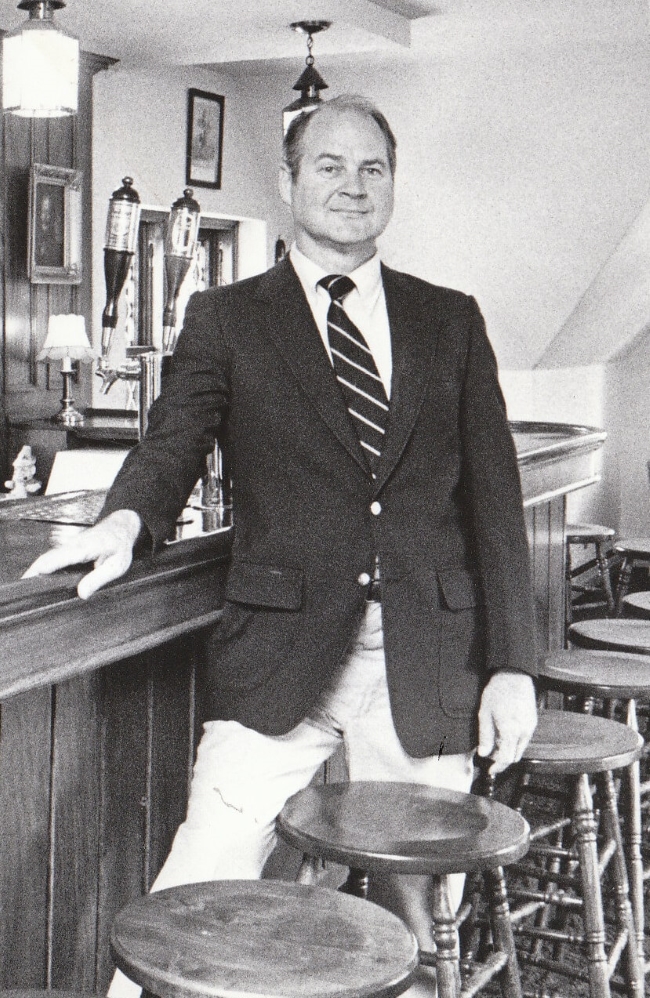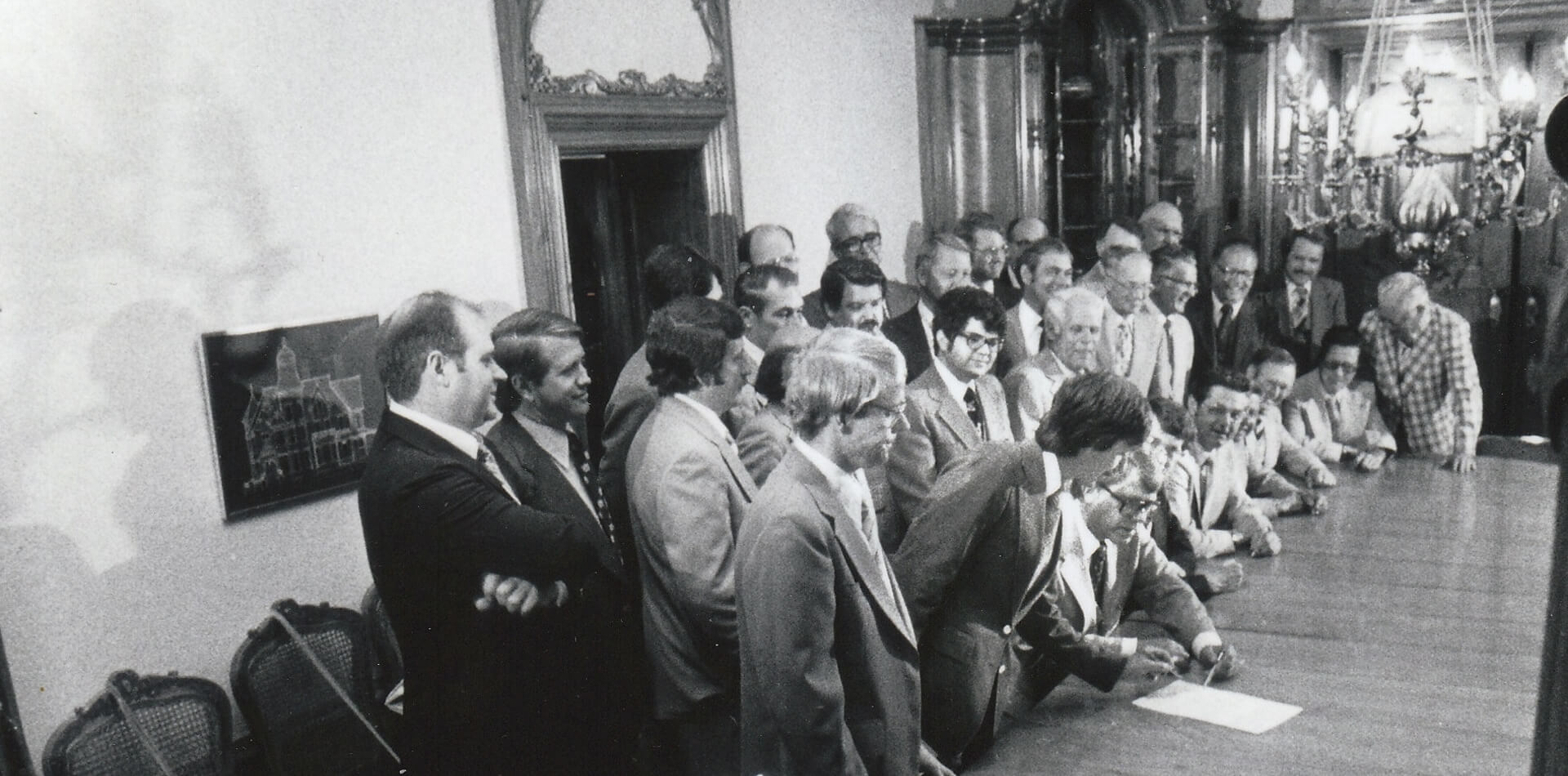By Pabst Mansion
Forty years ago this month, our organization was in the final stages of seeking funding in order to purchase the Pabst Mansion. The path forward was all but clear and a final positive resolution was anything but certain. From January of 1975 to May of 1978 the fate of the Pabst Mansion hung in the balance and it looked bleak for the historic home of Captain Pabst and his family. So many of the homes along Grand Avenue had already been demolished or modified beyond recognition to make way for multi-purpose commercial use. The large, mid-century commercial buildings flanking each side of the mansion suggested to many in Milwaukee what might become of the mansion and property at 2000 West Wisconsin Avenue.
For almost seven decades, the Catholic Archdiocese of Milwaukee had maintained the mansion as a residence, but in the mid-seventies decided the mansion and its carriage house were no longer sufficient to carry out their work. Early discussion regarding the potential sale centered on what would happen to the Pabst Mansion, one of Milwaukee’s most notable homes and an exceptional example of Milwaukee’s Gilded Age. Fears regarding its potential demolition led to the founding of a new preservation organization of concerned citizens who wanted to save the Pabst Mansion from being destroyed. Led by Milwaukee interior designer, Florence Schroeder, Wisconsin Heritages, Inc. [now known as Captain Frederick Pabst Mansion, Inc.] fought earnestly to raise enough funds to make an offer to purchase the home in order to transform it into a museum.
Milwaukee’s preeminent architectural historian, H. Russell Zimmermann in writing a plea to save the Pabst Mansion stated in a March 1975 Milwaukee Journal article, “If this landmark of landmarks is not capable of generating the interest and money necessary to save it from the wrecking ball, it is doubtful that anything in Milwaukee can be called ‘permanent’”. The following month, the Pabst Mansion was officially added to the National Register of Historic Places.
Throughout 1975, Wisconsin Heritages, Inc. (WHI) continued to raise funds and draw attention to the significant place of the Pabst Mansion in local, state and national history. The preservationists, however, were not the only people interested in the property. The building directly to the east of the mansion was once the Holiday Inn Central, a hotel whose singular claim to fame was that The Beatles stayed there when they were in Milwaukee in September 1964. Today, it has been repurposed as Mashuda Hall, a dormitory for Marquette University. The Holiday Inn needed parking and the adjacent property, including the Pabst Mansion, was the ideal site. By December of 1975, both the owners of the Holiday Inn and WHI were getting ready to make offers to the Archdiocese. In a surprise upset, the Archdiocese sold the house to the hotel, even though WHI was ready to submit an offer. As a contingency, the hotel had to extend a 10-year lease to WHI at the end of which the organization would have to remove the structure or it would be demolished. Undeterred, WHI continued its crusade to save the historic home for the next two years.

Image of the Holiday Inn Central
In 1977, Milwaukee entrepreneur, John Conlon stepped in and made a deal with the then-owners of the Holiday Inn Central to purchase the Pabst Mansion and its frontage on West Wisconsin Avenue, ceding off the north end of the property so the Holiday Inn would have space for their desired parking lot. While the newspapers at the time quote Conlon’s intention to use the Pabst Mansion for offices, it soon became apparent that he would hold the property until Wisconsin Heritages, Inc. could find a way to purchase the house in order to open it as a museum. Conlon provided WHI an option to buy the mansion by May 1, 1978. Now the organization had to find a way to raise $330,000. Today, of course, that does not seem like an impossible amount of money to raise, especially considering the importance of the Pabst Mansion as an architectural treasure. However, when one remembers that almost any mansion on Milwaukee’s Lake Drive could have been purchased for less than $200,000, the cost of the Pabst Mansion comes into better perspective.

Photo of John Conlon
WHI was awarded a $100,000 grant from the U. S. Department of the Interior towards the purchase, which was the largest grant given to any organization up until that time. There was still roughly $230,000 that needed to be raised in order to save our historic home and the fledgling organization was running out of options as the clock was ticking. By early April 1978, it became apparent that the only way WHI would be able to purchase the property was going to be through a bank loan, but this also proved daunting. Fifteen banks had turned the organization down for loans to purchase the property. It was a risk no bank wanted to touch—extending almost a quarter of a million dollars for the creation of a house museum.
With the deadline looming, Paul Hammersmith, husband of founding WHI board member, Donalda Arnell Hammersmith, approached Leon Arciszewski, president of the Savings and Loan Council of Milwaukee County, with the problem of the organization. Arciszewski, intrigued by the idea, took the issue back to the Savings and Loan Council. In perhaps one of the truest and most sincerest meanings of “creative financing”, Arciszewski came back to WHI with a response to the $230,000 question. Twenty-three members of his Savings and Loan Council had agreed to each provide a $10,000 loan, at 10% interest for twenty years, thereby extending to WHI the financing to close the deal to purchase the house from Conlon.
On April 29, 1978, Leon Arciszewski sat down at the head of the Pabst Mansion’s dining room table and announced to the press that an agreement had been made between WHI and the Savings and Loan Council. For the rest of his life, Arciszewski remembered this mortgage as one of the highlights of his career. His imagination and trust in the organization truly are a legacy to our community.

Photo of Leon Arciszewski
One month later, after loan agreements were processed and terms fully settled, the guarantors of the loan to WHI for the Pabst Mansion gathered once again in dining room to sign the final loan papers. It was at that moment that the Pabst Mansion set upon a new course, a restoration program that has returned the Mansion to its 1892 glory. This on-going restoration has also marked its rise to national prominence for the quality of the museum, its interiors, and the vision of the organization to provide an authentic Gilded Age experience to visitors.
The cause of historic preservation is a fragile thing. The future of buildings, landmarks and land can often times hang by a thread. It is difficult to think of Milwaukee without its most notable home, the Pabst Mansion. That loss to the fabric of our city could have easily been erased in the mid-1970s. Fortunately, for all of us, it not only survived, but has thrived thanks to those with the vision to preserve and restore. And in case you are interested, the loan was paid off in full in 1994, four years before it was due.

